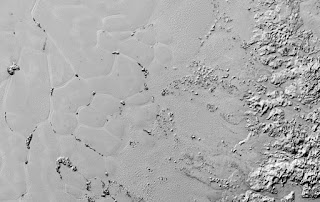 |
| Sputnik Planum on the surface of Pluto, as seen by the New Horizons spacecraft. Several polygons are visible in the image. (Courtesy: NASA/JHUAPL/SwRI) |
Topics: NASA, Planetary Science, Pluto, Space Exploration
The patchwork of polygons on the surface of a vast plain of ice on Pluto is created by heat upwelling from the interior of the dwarf planet. That is the conclusion of two independent teams of scientists that have combined data from NASA's New Horizons mission with computer simulations to gain a better understanding of Sputnik Planum – the flat region where the mysterious polygons exist. One important consequence of the convection process is that the surface of Sputnik Planum could be less than one million years old, making it one of the newest known surfaces in the solar system.
NASA's New Horizons spacecraft reached Pluto in July 2015, making it the first mission to explore the dwarf planet. The spacecraft has since provided scientists with a wealth of information about Pluto and its moons as well as the first images of Pluto's icy surface, which captured the imagination of scientists and the public alike.
Sputnik Planum, which is an ice-filled basin that occupies an area of about 900,000 km2, makes for a particularly interesting feature. The surface of the ice – which is believed to be mainly nitrogen – appears to be broken up into a collection of polygon-shaped tiles, each of which measure anywhere from 10–40 km across. The polygons are not flat – rather their centres rise up tens of metres above their edges to create a gently rolling icescape.
Physics World:
New Horizons lifts the lid on Pluto's peculiar polygons, Hamish Johnston
Comments